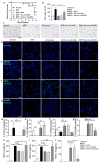Decorin Secreted by Human Umbilical Cord Blood-Derived Mesenchymal Stem Cells Induces Macrophage Polarization via CD44 to Repair Hyperoxic Lung Injury
- PMID: 31569732
- PMCID: PMC6801980
- DOI: 10.3390/ijms20194815
Decorin Secreted by Human Umbilical Cord Blood-Derived Mesenchymal Stem Cells Induces Macrophage Polarization via CD44 to Repair Hyperoxic Lung Injury
Abstract
Bronchopulmonary dysplasia (BPD), caused by hyperoxia in newborns and infants, results in lung damage and abnormal pulmonary function. However, the current treatments for BPD are steroidal and pharmacological therapies, which cause neurodevelopmental impairment. Treatment with umbilical cord blood-derived mesenchymal stem cells (UCB-MSCs) is an efficient alternative approach. To prevent pulmonary inflammation in BPD, this study investigated the hypothesis that a key regulator was secreted by MSCs to polarize inflammatory macrophages into anti-inflammatory macrophages at inflammation sites. Lipopolysaccharide-induced macrophages co-cultured with MSCs secreted low levels of the inflammatory cytokines, IL-8 and IL-6, but high levels of the anti-inflammatory cytokine, IL-10. Silencing decorin in MSCs suppressed the expression of CD44, which mediates anti-inflammatory activity in macrophages. The effects of MSCs were examined in a rat model of hyperoxic lung damage. Macrophage polarization differed depending on the levels of decorin secreted by MSCs. Moreover, intratracheal injection of decorin-silenced MSCs or MSCs secreting low levels of decorin confirmed impaired alveolarization of damaged lung tissues by down-regulation of decorin. In tissues, a decrease in the anti-inflammatory macrophage marker, CD163, was observed via CD44. Thus, we identified decorin as a key paracrine factor, inducing macrophage polarization via CD44, a master immunoregulator in mesenchymal stem cells.
Keywords: CD44; bronchopulmonary dysplasia; decorin; macrophage polarization; mesenchymal stem cell.
Conflict of interest statement
The funders had no role in the design of the study; in the collection, analyses, or interpretation of data; in the writing of the manuscript, or in the decision to publish the results.
Figures






Similar articles
-
Vascular endothelial growth factor mediates the therapeutic efficacy of mesenchymal stem cell-derived extracellular vesicles against neonatal hyperoxic lung injury.Exp Mol Med. 2018 Apr 13;50(4):1-12. doi: 10.1038/s12276-018-0055-8. Exp Mol Med. 2018. PMID: 29650962 Free PMC article.
-
Critical role of vascular endothelial growth factor secreted by mesenchymal stem cells in hyperoxic lung injury.Am J Respir Cell Mol Biol. 2014 Sep;51(3):391-9. doi: 10.1165/rcmb.2013-0385OC. Am J Respir Cell Mol Biol. 2014. PMID: 24669883
-
Human Umbilical Cord Mesenchymal Stem Cell-Derived Small Extracellular Vesicles Alleviate Lung Injury in Rat Model of Bronchopulmonary Dysplasia by Affecting Cell Survival and Angiogenesis.Stem Cells Dev. 2020 Dec 1;29(23):1520-1532. doi: 10.1089/scd.2020.0156. Epub 2020 Nov 4. Stem Cells Dev. 2020. PMID: 33040709
-
Anti-inflammatory and M2 macrophage polarization-promoting effect of mesenchymal stem cell-derived exosomes.Int Immunopharmacol. 2021 Aug;97:107823. doi: 10.1016/j.intimp.2021.107823. Epub 2021 Jun 5. Int Immunopharmacol. 2021. PMID: 34102486 Review.
-
Macrophages at the nexus of mesenchymal stromal cell potency: The emerging role of chemokine cooperativity.Stem Cells. 2021 Sep;39(9):1145-1154. doi: 10.1002/stem.3380. Epub 2021 Apr 6. Stem Cells. 2021. PMID: 33786935 Free PMC article. Review.
Cited by
-
Therapeutic Use of Mesenchymal Stromal Cells: The Need for Inclusive Characterization Guidelines to Accommodate All Tissue Sources and Species.Front Cell Dev Biol. 2021 Feb 16;9:632717. doi: 10.3389/fcell.2021.632717. eCollection 2021. Front Cell Dev Biol. 2021. PMID: 33665190 Free PMC article. Review.
-
Human placental mesenchymal stem cells regulate inflammation via the NF‑κB signaling pathway.Exp Ther Med. 2022 Sep 7;24(5):654. doi: 10.3892/etm.2022.11591. eCollection 2022 Nov. Exp Ther Med. 2022. PMID: 36168408 Free PMC article.
-
Advances in the Regulation of Macrophage Polarization by Mesenchymal Stem Cells and Implications for ALI/ARDS Treatment.Front Immunol. 2022 Jul 8;13:928134. doi: 10.3389/fimmu.2022.928134. eCollection 2022. Front Immunol. 2022. PMID: 35880175 Free PMC article. Review.
-
Donor heart preservation with hypoxic-conditioned medium-derived from bone marrow mesenchymal stem cells improves cardiac function in a heart transplantation model.Stem Cell Res Ther. 2021 Jan 13;12(1):56. doi: 10.1186/s13287-020-02114-7. Stem Cell Res Ther. 2021. PMID: 33435991 Free PMC article.
-
Characterization of the Proteins Secreted by Equine Muscle-Derived Mesenchymal Stem Cells Exposed to Cartilage Explants in Osteoarthritis Model.Stem Cell Rev Rep. 2023 Feb;19(2):550-567. doi: 10.1007/s12015-022-10463-4. Epub 2022 Oct 22. Stem Cell Rev Rep. 2023. PMID: 36271312 Free PMC article.
References
MeSH terms
Substances
Grants and funding
LinkOut - more resources
Full Text Sources
Research Materials
Miscellaneous

